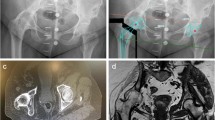Abstract
Total hip arthroplasty is a successful procedure for treatment of painful hip arthritides. A large volume of literature is devoted to the patient outcomes and complication profiles of the commonly used surgical approaches to help refine the technique, enhance patient function, and limit cost and patient morbidity. The direct anterior approach has been reported using a fracture table to promote surgical exposure to the proximal femur. This technique is described herein with attention paid to the technical points which facilitate surgical exposure, patient safety, and functional outcome. Following a literature review of recent reports using this procedure are reviewed in context of the reported complications. The results show the direct anterior approach using a fracture table performed by experienced surgeons is an effective technique which provides early postoperative function and reduces the risk of dislocation.
Similar content being viewed by others
References
Papers of particular interest, published recently, have been highlighted as: • Of importance •• Of major importance
Ethgen O et al. Health-related quality of life in total hip and total knee arthroplasty. A qualitative and systematic review of the literature. J Bone Joint Surg Am. 2004;86-A(5):963–74.
Jolles BM, Bogoch ER. Posterior versus lateral surgical approach for total hip arthroplasty in adults with osteoarthritis. Cochrane Database Syst Rev. 2006;3:CD003828.
Masonis JL, Bourne RB. Surgical approach, abductor function, and total hip arthroplasty dislocation. Clin Orthop Relat Res. 2002;405:46–53.
Judet J, Judet R. The use of an artificial femoral head for arthroplasty of the hip joint. J Bone Joint Surg. 1950;32B:166–73.
Barton C, Kim PR. Complications of the direct anterior approach for total hip arthroplasty. Orthop Clin North Am. 2009;40(3):371–5.
• Jewett, B.A. and D.K. Collis, High complication rate with anterior total hip arthroplasties on a fracture table. Clin Orthop Relat Res, 2011. 469(2): p. 503–7. Large series with detail of complications observed and depiction of the author’s decreased intraoperative complications, but stable postoperative complications, as the series progressed. This highlights the importance of surgeon experience with this technique to achieve optimal patient outcomes.
Mast NH, Munoz M, Matta J. Simultaneous bilateral supine anterior approach total hip arthroplasty: evaluation of early complications and short-term rehabilitation. Orthop Clin North Am. 2009;40(3):351–6.
•• Matta, J.M., C. Shahrdar, and T. Ferguson, Single-incision anterior approach for total hip arthroplasty on an orthopaedic table. Clin Orthop Relat Res, 2005. 441: p. 115–24. Detailed account of the author’s technique and overview of operative outcomes and complications, including intraoperative fractures.
• Sariali, E., P. Leonard, and P. Mamoudy, Dislocation after total hip arthroplasty using Hueter anterior approach. J Arthroplasty, 2008. 23(2): p. 266–72. Large prospective series which assessed patient factors contributing to dislocation after undergoing total hip arthroplasty with this technique. The authors also conrasted dislocation rates of the other main total hip approaches.
• Siguier, T., M. Siguier, and B. Brumpt, Mini-incision anterior approach does not increase dislocation rate: a study of 1037 total hip replacements. Clin Orthop Relat Res, 2004(426): p. 164–73. Retrospectively conducted large study showing similar dislocation rates across literature reports of other studies.
• Woolson, S.T., M.A. Pouliot, and J.I. Huddleston, Primary total hip arthroplasty using an anterior approach and a fracture table: short-term results from a community hospital. J Arthroplasty, 2009. 24(7): p. 999–1005. Retrospective report of community surgeons experience with the direct anterior approach using a fracture table after adopting this technique without formal training. The authors detail the significant complications that can be encountered in this setting.
Kwon MS et al. Does surgical approach affect total hip arthroplasty dislocation rates? Clin Orthop Relat Res. 2006;447:34–8.
Disclosure
No conflicts of interest relevant to this article were reported.
Author information
Authors and Affiliations
Corresponding author
Rights and permissions
About this article
Cite this article
Horne, P.H., Olson, S.A. Direct anterior approach for total hip arthroplasty using the fracture table. Curr Rev Musculoskelet Med 4, 139–145 (2011). https://doi.org/10.1007/s12178-011-9087-6
Published:
Issue Date:
DOI: https://doi.org/10.1007/s12178-011-9087-6




